Game of Thrones and Violence: Don’t Gore Breaking my Heart
Game of Thrones is often criticised for its use of nudity, sometimes fairly and other instances not so much. In fact, the nudity in Game of Thrones often gets some unfair treatment and is sometimes thoughtlessly considered gratuitous. There are even some articles such as “Ugh, Game of Thrones, Why So Much Unnecessary Humping?” on Jezebel.com written by Emily Anderson. This article almost jokingly discusses the nudity on the show, but the violence on the show is perhaps just as pointless sometimes and does not nearly seem to get as much coverage as the nudity.
As with the nudity, Game of Thrones has got somewhat of a stigma surrounding the violence it portrays. Similar to the nude scenes, the violence and gore on the show have come under fire for being gratuitous, overly graphic and generally used too much. Some have even labelled the show’s violence as “self-sabotage” on the blog “Remote Wanderings”. However, it is the nude scenes that take much of the media attention (mostly on social media) although this itself can be attributed to scenes of sexual violence with many of the nude scenes also playing their part. The “outrage” against the nudity does seem rather unprecedented when compared to the violence, especially seeing as violent and gore heavy scenes seem to be more prominent from the show than even the nudity.
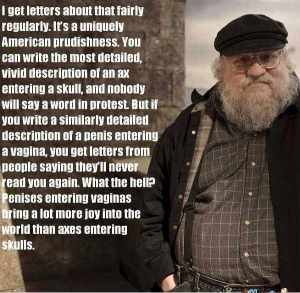
One would have thought that violence in film and television would receive more attention in general, but for some reason a naked body is more frowned upon whether it is prurient (intended to cause arousal) or not. Nudity or nakedness may not always be there to arouse. It can be used for a variety of reasons. Violence, however, while it can also have a multitude of factors for its use, is still violence. An exposed breast can be prurient or not depending on the context it is shown in, but a stabbing, whether portrayed as a piece of sadism or as a single, calm stab to the heart, is still a violent act. Even George R.R. Martin, the author of the acclaimed A Song of Ice and Fire series of books and sometime scriptwriter for the show, has said that he is “astounded” that audiences are seemingly more concerned with sex and nude scenes as opposed to the violence.
So why exactly do the scenes of graphic violence and gore not seem to incense the show’s audience and critics as much as the violence? We (the audience) as a whole have been almost completely de-sensitised by violence because of constant exposure to it from other television programmes, films, the news and even social media. Because nudity hasn’t had the same media exposure, audiences become so much more aware of it when it is shown on-screen. In this article I shall analyse several scenes, aspects and characters of the show that are heavily entwined with violence and gore, seeing if there is any artistic integrity to these examples before trying to explain further why these instances don’t get the same attention as a nude scene might do.
The Mountain That Rides
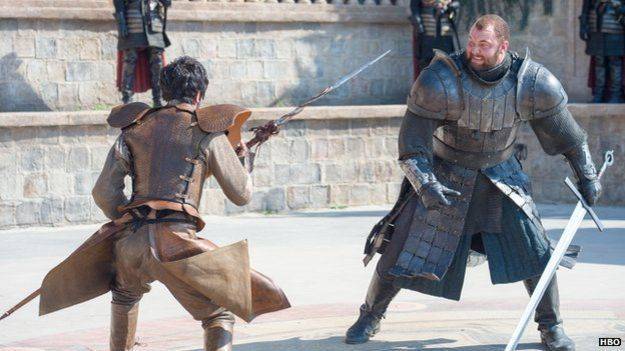
Ser Gregor Clegane, otherwise known as “The Mountain That Rides” or more commonly just “The Mountain,” has had a fluctuating relationship with Game of Thrones. A total of three actors have portrayed the character so far in the five seasons to have aired and he has had a very short amount of screen time. His brother, Sandor “The Hound” Clegane (Rory McCann), has somewhat stolen the limelight from his brother (which is slightly ironic as The Mountain is probably the more renowned Clegane brother) but what the Clegane brothers share is a violent nature. And this is one of the few characteristics the show has shown The Mountain to consistently have.
One of the first and very few instances we see The Mountain is in the season 1 episode 4 “Cripples, Bastards and Broken Things,” in which Petyr “Littlefinger” Baelish (Aiden Gillen) tells Sansa Stark (Sophie Turner) the story of how The Mountain pushed his brother’s face into a fire-place, just because he was playing with his toy. This violent and angry part of the character is realised in the episode “The Wolf and the Lion” when, after being thrown from his horse in a jousting match, The Mountain draws his sword, kills his horse and strides angrily towards his opponent with the obvious intention of killing him. However, he is thwarted by his brother The Hound and their short skirmish is soon ended by King Robert Baratheon (Mark Addy). The Mountain then throws his sword down to the ground and storms off, much like a child would. While this scene isn’t particularly graphically violent, it still holds some importance to certain characters, but not so much to The Mountain. It does show how physically strong and quick to anger he is, but this is a set-up to the character that will not pay off for some seasons.
In the books every so often there is a mention of a horrific occurrence involving The Mountain and these tales, which come by word of mouth, gives The Mountain an almost legendary status in Westeros. However, this is not possible in the show and but for a sparing couple of tales, the show doesn’t give much in way of educating the audience about how utterly terrifying The Mountain actually is. Therefore, these scenes act as nothing more than some fairly pointless exposition. This is especially noticeable in his return to the show in season 4. Having not appeared for 18 episodes, missing an entire season (and once again being recast) the return of The Mountain occurs in the episode “Mockingbird,” in which he is, apparently needlessly, killing peasants and disemboweling them before being approached by Cersei (Lena Headey). This scene is over with quickly and the dialogue is in short supply giving the scene very little substance.
Because it has been so long since the characters last appearance, his recasting and lack of tales about his raids and tortures, this scene only acts to re-introduce viewers to the character and nothing more. Whereas a nude scene such as the one where Melisandre addresses Selyse Baratheon in the nude to subtly show the power dominance of The Red Lady over the Queen, the scene with the Mountain literally showing his physical power is much more vulgar. Had this scene not been included it would not have harmed the episode in any way and nor does it really add much to the pay off in the next episode, “The Mountain and the Viper.”
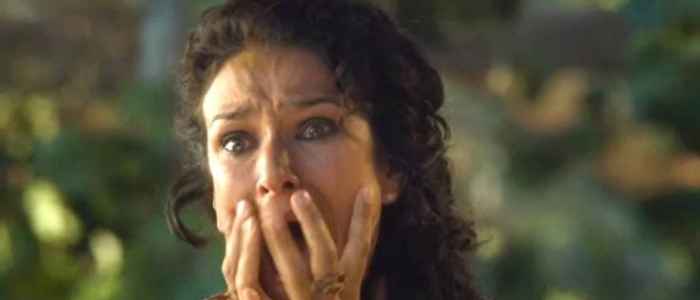
This episode is the date of Tyrion Lannister’s (Peter Dinklage) trial by combat, which will ultimately judge his fate regarding whether he killed his nephew, Joffrey Baratheon. In Tyrion’s corner is the Dornishman, Oberyn Martell, and in Cersei’s, Ser Gregor. It is observable just from the size of the two combatants that their fighting styles and strategies will be very different. This is all the more clear when the actual violence (the fighting) begins. Oberyn exploits a variety of flips and extravagant moves, fighting with a long spear and The Mountain fights much slower than his opponent, but his strength is never in doubt. The fight is excellently choreographed and the way the champions fight perfectly reflect their personalities; Oberyn is confident and cocky while the Mountain is quick to anger, aggressive and unforgiving.
While on the floor and apparently defeated, The Mountain seizes his chance in a moment where Oberyn loses his concentration. Ser Gregor knocks the Prince to the ground, punching him in the face and then crushes his skull with his bare hands. The actual head crushing is sickening, but it is the shriek from Ellaria Sand that sends goosebumps down one’s spine and reflects the reaction of the audience. With this moment, the scene encompasses several well-done traits of violence and gore: the shock that Oberyn has been defeated and is dead, the sickening feeling from The Mountain’s actions itself and finally a feeling of distraught that this could mean the end for Tyrion (which fortunately didn’t happen). But with a scene having so much power and emotional pull with the audience with just a few seconds, it really calls into question the previous scenes with The Mountain. His scene with Cersei becomes ever more questionable after viewing such an intense scene and thus highlights other scenes of pointless violence that aren’t anywhere near the level of the well-executed aspects of violence in this trial by combat scene.
The Mountain can be seen as a literal personification of violence and how it is portrayed on Game of Thrones. It is brutal, sickening and not always necessary. While some of The Mountain’s scenes do reflect both his personality and certain aspects of the show, they can be fairly gratuitous, serving purely as exposition to the audience. Yet on one occasion involving The Mountain violence is used as a tool to create tension and to provide an element of narrative surprise. This really shows the two extremes to how the show has exploited violent sequences in the past. While Game of Thrones puts a lot of focus on the violent nature of one character, they have on more than one occasion used entire episodes that revolve almost entirely on violence.
Blackwater, Castle Black and Hardhome
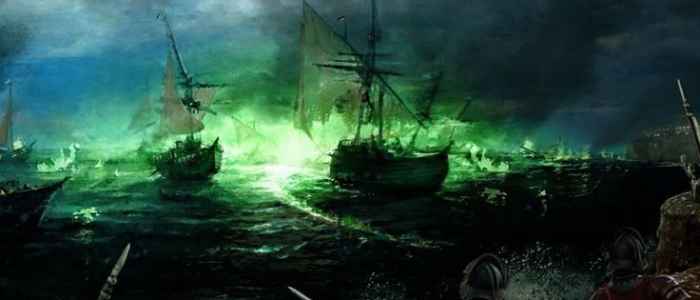
There are many scenes that have been overly graphic with the violence that has been portrayed on the show. Kyle Tanner of Gin Alley, Lord of Craster’s Keep, The Hound killing chickens at the Inn at the Crossroads and of course, whenever The Mountain decides to show his face. But sometimes entire episodes on Game of Thrones revolve around violent conflicts. There are two episodes in particular that completely revolve around violence with a third basing a large majority around it: “Blackwater,” “The Watchers on the Wall” and “Hardhome.” The former two are based around battles at Blackwater Bay in King’s Landing (season 2, episode 9) and Castle Black (Season 4, episode 9), while the final episode is named after a Wildling settlement beyond the Wall where the Night’s Watch and a band of Wildlings battle off against a horde of wights and White Walkers.
All three of these episodes have rightly been touted as some of the shows greatest, yet for a show that has a fantastic array of characters and a compelling story, it’s a little surprising that these episodes are critically acclaimed seeing as they are battle oriented episodes, which sometimes lack substance and creativity. This is not the case with these episodes, however. In “Blackwater” there are some brilliant scenes such as Tyrion addressing the soldiers of King’s Landing and Cersei almost murdering her son Tommen to save him from being killed by Stannis Baratheon’s men. Then with “The Watchers on the Wall” there is the constant tension concerning the inevitable encounter of Jon snow (Kit Harrington) and Ygritte (Rose Leslie). And finally with “Hardhome,” although the conventions of a battle sequence are all very familiar, the cinematography and music are used to create a feeling reminiscent of horror movies.
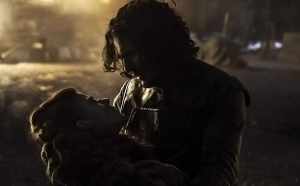
Aspects such as the cinematography in these episodes are also incredibly good, with one standout example coming in “The Watchers on the Wall” with the violence of the Battle at Castle Black very much centred around it. The scene in question occurs just as Jon Snow returns to Castle Black after commanding men atop the Wall, with a one-take panning shot taking in the entire battle on ground level. This 360 degree shot allows the audience to see different aspects of the battle as well as following characters that we as the audience already know well such as Jon Snow and Samwell Tarley (Jon Bradley). This shot brings together several aspects of filmmaking, with the moulding of the music around the sequence being particularly well done.
Starting and ending with a variation on the show’s theme, just as it does with Jon and Sam, with the Thenns theme sandwiched in-between when the Thenns appearing in the shot. This shot shows how well three different aspects – cinematography, misé-en-scene and sound (diegetic: the sounds of the battle and non-diegetic: the music) – can be moulded together and it took a violent scene (and episode) for it to be pulled off.
All these episodes offer very inane, yet visually pleasing shots. Whether this is the burst of green flames of wildfire, a giant scythe sweeping across the Wall or the Night’s King raising the dead to join his army. But these violent episodes do still have some substance and offer something the story. Both “The Watchers on the Wall” and “Hardhome” offer something to the overall narrative of the show with their incredibly violent episodes and they just so happen to both involve Jon Snow.
If the Battle of Castle Black shows anything, it is that the Night’s Watch is in serious need of leadership and a permanent Lord Commander. Ever since the death of Jeor Mormont (James Cosmo) in the season 3 episode “And Now His Watch is Ended,” Ser Alliser Thorne (Owen Teale) has taken temporary charge of The Watch. Thorne is the one who takes charge during the Battle of Castle Black, commanding from atop the Wall and on ground level until he is injured and can no longer fight. The next man to take the lead atop the Wall is Lord Janos Slynt, the personification of why the Night’s Watch needs a strong and willing leader. Slynt becomes delusional and is told he is needed down below, but he eventually ends up cowering in a room with Gilly and her baby. This is when Jon steps up, keeping the Wildlings beyond and climbing the Wall at bay before he too is called below. Jon essentially wins the fight for the Watch with his killing of the Magnar of the Thenns, with his commands to those atop the Wall and those who fought the gate fighting a giant also playing a huge role.
Jon’s leadership and courage is once again shown when he leaves to go beyond the Wall and meet with Mance Rayder (Ciarin Hinds). This all foreshadows the eventual appointment of Jon Snow as Lord Commander of the Night’s Watch and this could only have been done in the midst of a battle. Showing his strategic, leadership and combative qualities. It is true that the entire series has foreshadowed Jon’s eventual rise to Lord Commander, Samwell even once tells Jon that Mormont is grooming him to take over in the future, but this is the episode that all but confirms his future election as the Lord Commander.
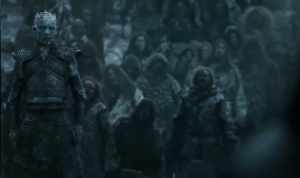
Jon also has narrative importance during the “Hardhome” episode, but this plays a much more important part in the entire universe of both Game of Thrones and A Song of Ice and Fire. During a sequence beyond the Wall at the Wildling settling of Hardhome, the band of Night’s Watchmen and the Wildlings are ambushed by the White Walkers. This segment of the episode (which exhibits some horror tropes to it and very little dialogue) may not be the first thought as a place that will add anything to a story, but dialogue is not needed for this revelation to be uncovered. As the battles rages Jon comes face to face with a White Walker and this fight very nearly ends Jon’s life, but just as the White Walker is about to land the killing blow, in one desperate attempt Jon grabs his sword from the floor, blocks the attack and kills the White Walker. By doing this Jon has become only the second person (in the canon of the show) to kill a White Walker in over a thousand years. This itself is huge, but the means by which Jon achieved this feat is even bigger. The sword that Jon used to kill the White Walker is named Longclaw, the sword given to Jon all the way back in season 1 by Jeor Mormont and it is made from Valyrian steel. This hails a huge development in both the book and television series’, as what was just suspicion and theory in the books has been confirmed by the show; Valyrian steel can kill White Walkers and this should play a huge part to play with what is to come next in both canons.
These three episodes portray a vast amount in variety in how violence and gore can be portrayed as well as showing how many different purposes violence can have. Yet these episodes are still largely touted as some of the show’s finest and they, for the most part, revolve around scenes of great violence and gore and still this does not get the same recognition as the show’s nudity, which is no worse than the violence in terms of how it is portrayed and how prolific the scenes are. Each of these episodes can probably be named as “landmark” episodes, being some of the most renowned episodes and they obviously revolve around violence. But sometimes a “landmark” episode can be remembered for just one scene or sequence. One piece of incredible violence that would catch viewers completely off guard.
The Red Wedding
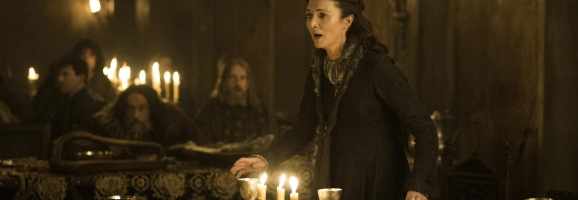
One useful aspect of violence, evident in the fight between The Mountain and The Red Viper, is that of shock and on occasion an episode is remembered purely for one scene of incredible violence. This can both be a visual type of shock (what is actually portrayed on-screen is difficult to look at) as well as a narrative shock. The death of a beloved character would be an example. Or in this case, several characters. The penultimate episode of season 3, “The Rains of Castamere,” played host to one of the most surprising sequences in terms of character deaths, in which the closest people the audience has to protagonists in Robb and Catelyn Stark (Richard Madden and Michelle Fairley, respectively) die during the now famously named Red Wedding.
While in attendance at his uncle’s wedding to one of Walder Frey’s (David Bradley) daughters, the tables take a sudden and upsetting turn for Robb and Cat. With the two newlyweds having had their bedding ceremony and now out of the picture, Lord Frey presents the King in the North with a “wedding present.” Robb’s wife Talisa (Oona Chaplin) is stabbed in the stomach multiple times, killing her and her unborn child. A barrage of crossbow bolts are sent from higher standings and other Frey men initiate stabbings all over the room, eventually ending with Catelyn’s throat being slit. The episode ends cutting to the credits with no music being played over them for the first time.
To call this a bloodbath would be an understatement, with the amount of violence shown inside and outside The Twins being abundantly graphic. Of course, both the violence and deaths of Robb and Cat were (and still are) incredibly shocking, with the violence only adding to the narrative bombshell. Imagine if the characters that matter most to us (the audience) had died peacefully, in their sleep. The sadness may have still been there, but the impacts of their deaths wouldn’t have had quite the same effect. The fact that these characters have been killed in the most brutal way possible really strikes into the hearts of the audience.
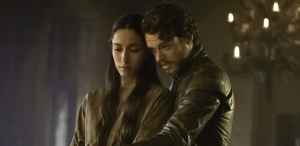
This sort of event, forgetting any of the violence in the scene for just a second, fits in perfectly with what George R.R. Martin created originally with his A Song of Ice and Fire series; something that goes against the traditional cliques and stereotypes of the fantasy genre and that actions will have consequences, no matter who you are in his world. But with this, the showrunners have been created a problem: the book readers. Those who have read Martin’s books will know about events that have already happened in the books (although now the show has gone past much of what the books have done) and to make things worse, each individual reader will have an image of what has happened in the books in their minds. Now there are two ways these problems can be addressed and can shock book reader-viewers (specifically regarding the Red Wedding): to have characters that don’t die in the books die in the show and to have the violence eclipse the books and the readers’ imaginations.
Point one is accomplished with the character of Talisa Maegr whose book counterpart, Jeyne Westerling, is still alive in the books. Jeyne did not attend the wedding out of respect for Lord Walder and to not further anger him, meaning Talisa’s appearance is a huge deviation from the source material. Although this itself may not come as a shock to book readers as Jeyne has lost hers and Robb’s child and is in no way a major (or even minor) character. This means that the show must go out of its way to shock the reader-viewers with its use of violence. Thankfully, what the show does, as it does on so many occasions, is to find a compromise between the two mediums “pleasing” both sets of fans. The narrative shock is enough for pure show watchers, while inclusions of new character deaths and almost overly graphically violence (even though in A Storm of Swords there are occasions where the gore outdoes the show) can still affect the book readers, even though they knew exactly what was coming.
Theon Greyjoy’s Torturous Transformation
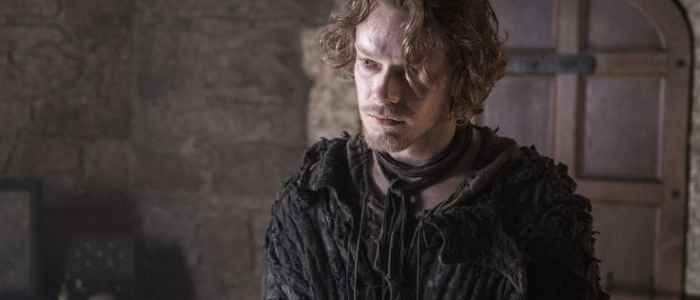
There have been pointless, expositional violence in some scenes with the Mountain and other scenes where the violence has enhanced the scenes and heavily impacted audiences (as they should). The violent torture scenes of Theon Greyjoy (Alfie Allen) in season 3 can be found in an odd position between these two extremes. After having apparently murdered Bran and Rickon Stark and been betrayed by his own men at Winterfell, Theon finds himself at the hands of some unknown assailants, who later come to be confirmed as men of Roose Bolton’s bastard, Ramsay Snow.
During Theon’s arc in season 3, there are only a small number of scenes which don’t portray him being tortured, even when he is rescued his saviour is the one playing with him and brings him back and then tortures the Ironborn prince himself. All of these scenes are incredibly difficult to watch. From having his finger nails removed to even almost being raped by two women before Ramsay ends up castrating him. The scenes themselves aren’t overly graphic (at least not to the extent of the previous scenes I’ve looked at) in terms of their violence or gore, but other than assuming that these men follow Robb Stark and are pursuing revenge on his behalf (knowingly or not) these scenes just seem pointless and almost torturous to those watching.
These instances do not occur in the books in the form of a POV chapter for Theon. In fact, his character takes a two book hiatus from having a POV chapter and the eventual revelation that Reek is Theon is intended to be a surprise for the readers. Obviously, this type of shock isn’t possible on the show as the audience can identify these characters from their appearances and why they’ve had to take different directions with characters like Theon (Ser Barristan Selmy being another example). However, it is Alfie Allen’s scenes as Reek that saves the torture scenes from being completely useless. Allen’s performances as Theon as Reek are excellent. You see a man completely broken, a man who has nothing left and now serves, without question, the man who tortured him for an entire season. In fact, Theon/Reek is barely recognisable as a human being anymore. He even sleeps in the kennels with the Bolton dogs. He is just an animal now.
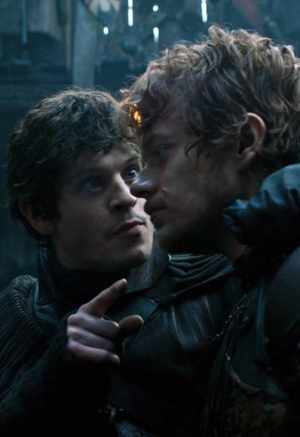
Theon’s transformation is essentially an extravagant and long set-up and pay-off. To truly appreciate the “thing” Theon has become, the audience must go through his journey, his transformation, his torture with him. Suddenly all of Reek’s ticks make the torture scenes relevant. This is a new character and this almost entirely makes up for the difficult to watch season 3 scenes. Of course, the obvious rebuff to this would be “would this have played out any better if we didn’t have Theon’s torture scenes?” and one cannot possibly answer this. It would have at least made the audience wonder what the Boltons did to Theon and given viewers more to talk about and theorise, but that would also mean there would not be any character development for the one on the other half of this relationship: Ramsay. As much as these torture scenes are a character change for Theon, they also show the masochistic nature of Ramsay Bolton née Snow. So perhaps without those torture scenes Ramsay’s actions would make even less sense to the audience, so at the very least this acts as a suitable introduction to Ramsay.
Much of Theon’s torture should create some discourse within the audience of Game of Thrones. Yet these scenes didn’t seem to cause much of a stir. Perhaps this is because of the stretched out nature of this particular act (or acts) of violence as these events take place over the entirety of a single season, or maybe if this was a female character being tortured it would have had a much more memorable backlash. What reaction would there have been from the audience if those two women had gone on to rape Theon as opposed to Ramsay interrupting and cutting off Theon’s favourite toy? Most likely there would have been some outrage, but these scenes should have created more of a discourse. Did Theon deserve this? Is torture, waterboarding, tactical questioning acceptable in reality? What if it saves millions of lives? So many questions and debates should have come out of this accumulation of violent events, but there seems to be so little, not just regarding Theon’s torture but most of the violence on Game of Thrones, especially when compared to the nudity on the show.
Why Doesn’t the Violence Get the Same Attention?
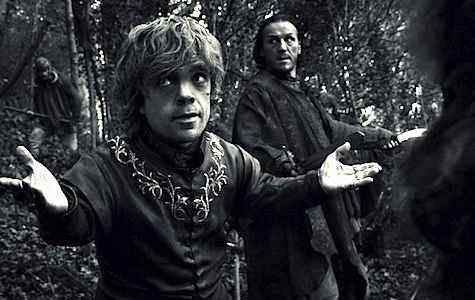
These examples of violence and gore are really a mixed bag with regards to their quality, importance, purpose and aesthetics. Some advance the plot with foreshadowing and new revelations, others offer shocks to both book readers and pure show watchers, some are only credible after a payoff and some are purely expositional. All these scenes have both merits and faults, but any attention the violence in this show receives is still outmatched by that received by the nude scenes, even though scenes that contain violence and/or gore are much more recurrent than nude scenes. In fact, in the series premiere, “Winter is Coming” there are 4 scenes that contain some sort of violence or gore before the first scene with any nakedness/nudity. It would be fair then to take a well-educated assumption that there are more examples of violence within the show than there is nudity. Yet more attention, analysis and even outrage surrounds that of the nudity on the show. So why exactly is there less attention (for the most part) with regards to the very graphic violence and gore portrayed on Game of Thrones? One such answer could come in the form of the genre of the show, with it being fantasy.
Even though the A Song of Ice and Fire series breaks some fantasy tropes (all characters are morally grey, as opposed to being either wholly good or evil) it still maintains many elements that make it a fantasy book and television series. The majority of these fantasy tropes are more semantic than syntactic, they are more to do with the images audiences associate with the genre as opposed to what is expected from it thematically and as a narrative. In fact, if the story of Game of Thrones were to be set in the present day at the White House or Houses of Parliament, you would think of it as a political drama, especially the story line(s) based in King’s Landing. Even so, there a still so many elements of fantasy that are still integral to Westeros. There is the medieval setting, clothing, vocabulary, Daenerys’ dragons, the White Walkers, magic in the form of resurrection, shadow baby demons and warging (the ability to go within an animal or even a human being and controlling them) plus there is the huge amount of mythology and lore surrounding the whole world of A Song of Ice and Fire. But another key constant within the fantasy genre is there is usually a huge conflict of sorts.
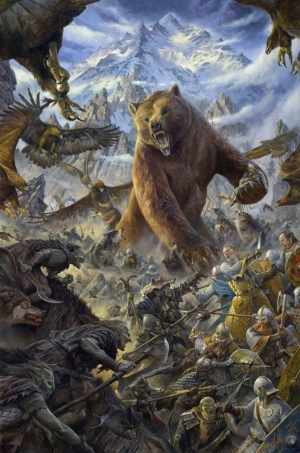
These conflicts predominantly come in the guise of battles and war, so as a generic property, fantasy will more often than not, have to include some element of violence into its story. Yes, sometimes the conflict within a fantasy world can be an internal, mental and emotional one but for the most, part the conflict is battle and/or war related. In Tolkien’s mythology on Arda (the name he gave to the entire world that contained Middle-Earth) there are countless battles and wars. To just name a few there were: The Kinslaying at Aloquonde, the Battle of Unnumbered Tears, the War of Wrath and two of the more well-known ones, the Battle of Five Armies (brilliantly illustrated to the left) and the War of the Ring. Even in more contemporary fantasy tales such as the Harry Potter series, it culminates in one final battle at Hogwarts. This is the case too with something a little bit more conservative, like BBC’s Merlin. A show that would usually air between 7 and 9 pm, so because of a younger audience it could not show anything graphically violent (or any nudity for that matter) but there is still a ton of fighting and once again leads up to a battle in its penultimate episode and series finale.
This then leads to the fact that violence is needed in works of fantasy to back the authenticity of a specific story. If something is set around of or in the middle of a war, then there is a good chance that there is going to be some piece of violence exhibited. Whether this is a full-blown battle or maybe something more consequential like a punishment. A beheading, for example. But while the violence is all but an integral element to fantasy as a genre, there are barely any examples of nudity at all and this is where the explanation as to why the nudity and nakedness in Game of Thrones gets more attention than its violence and gore.
The fantasy genre is not inherently linked to sex or naked bodies at all. Sure, modern fantasy has some roots in older mythologies (Greco-Roman being one example, which had endless evidence of sex and nudity) and fairy tales (which had many analogies of rape) but modern fantasy, by which I mean the (re)invention of the genre that began with the works of Tolkien and C.S. Lewis and perhaps even earlier with George MacDonald, has very little links with any form of sex or nudity. However, this is all part of the point of Game of Thrones and A Song of Ice and Fire. The two series’ make a point of trying to break convention of traditional storytelling and distorts the conventions of the fantasy genre on purpose, which includes the implementation of nakedness, nudity and sex.
Finally, whether part of the fantasy genre, a piece of fiction in general or through more “real” mediums such as the news, violence has been a part of mainstream media for decades, so much so we, as a societies and cultures, are becoming de-sensitised to it. That’s not to say that violence has no effect on people or sympathy with those who have been on the receiving end has been eradicated, it is just not as shocking to audiences anymore. Violence in this world and imagined worlds is taken as a given. But when it comes to nudity and sex there is minimal exposure. Any examples are mainly confided to Indie films and World Cinema, as well as the sexploitation films of the 50s and 60s (Russ Meyer’s Faster, Pussycat! Kill! Kill! being perhaps the most well-known example) that are most definitely not anywhere near mainstream consumption.
Any piece of nudity or act of a sexual nature in mainstream media is very few and far between. In films such as 300 and 300: Rise of an Empire, the nudity is very sparing although they are films that lend themselves to a mythology quite heavily related to the naked human body. When it comes to television the American broadcaster HBO is probably the most prolific at exploiting nudity with shows like The Sopranos (Tony Soprano’s hold up is a strip club) and of course, Game of Thrones. Any instance of nudity that appears via the media that isn’t fictionalised usually comes in the form of a documentary, but then quite often any piece of nudity is seen as tribal. These people being filmed are none the wiser that their exposed breasts or penises are not socially acceptable in Western culture and are therefore not “threatening” or prurient to the audience.
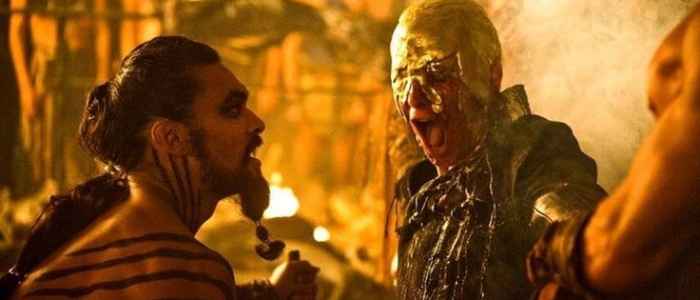
Audiences and even societies have all become rather prudish (to varying extents) because of the lack of nudity exhibited through various mediums and hence any piece of nudity that are exhibited become are all the more noticeable because this is not usual in mainstream media. But this is almost dismissed as something that has become so common in the media in violence (and gore retrospectively). So even when a television show like Game of Thrones is more prolific with its violence than its nudity and is arguably more gratuitous with its use of graphic violence, we as an audience, have become somewhat de-sensitised to it and this is most probably why the violence and the gore in Game of Thrones isn’t as scrutinised as much as the nudity is.
All of this really accumulates to why the nudity and sex scenes are (seemingly) more focused on than a lot of the shocking violence and gore. The audience being de-sensitised from violence is key to this discussion, having been exposed to so much violence throughout the years and so little nudity and sex from mainstream media. This point is only further enhanced by the fact that nudity has never really played any major part in the fantasy genre wheeras violence and conflict have played a huge role. Relationships have always been very clean-cut, full of love and sex is almost a myth in what has become known as modern fantasy. A Song of Ice and Fire and Game of Thrones breaks this convention of the fantasy genre, making sex, nudity and even rape a part of its world. When something is barely shown to audiences it becomes more noticeable when it is shown and when convention is broken. However that is done, the audience will once again notice this more than something that has been a part of convention for years. Both of these points are really integral to why the violent and gore heavy scenes, both well executed and not, are not given as much attention as the nudity on the show is.
What do you think? Leave a comment.
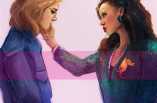
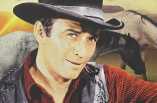
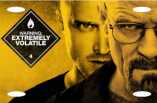

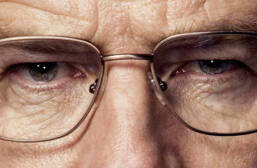


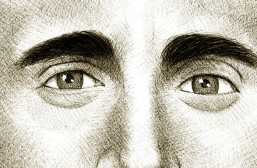


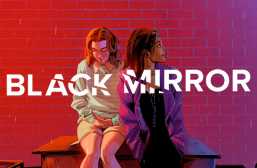
Some of us like things being brutal. Waiting for April.
The violence fits in with the fantasy world as GRRM structured it. It’s a show about awful people doing awful things to stay in power. If Sansa married Ramsay and he was perfectly sweet (or even just “not terrible”) to her it would be totally out of character for him. We’re trying to impose our real-world sensibilities on this fantasy world. If we start doing that, then we make characters behave as we want them to, which destroys the point of the story.
For me the non stop pointless nudity, mainly female, is very disappointing I have lost count of the number of times women are paraded around while someone chooses ….IMHO
The only one I want to see die a brutal death is Ramsay Bolton. But I would settle for Sansa just neutering him in his sleep and then stabbing him through the heart. Several times.
Excellent work on this article! I like how it turned out.
Thank you! I really appreciate the help you gave me
They should just bite the bullet and bring Sean Bean back. It would make no logical sense as his character is dead but they have to try something right? It can’t carry on like this.
It’s been a brilliant series thus far, it’s been building and building, Can’t wait for the conclusion… in 10 years!
It’s not been more brutal, it’s just got a lot more casual watchers due to its popularity.
Great article, which sums up all the arguments pretty well!
Thank you! 🙂
Mediaeval drama fails to live up to 21st century ethical standards shock horror.
There is really nothing “medieval” about Game of Thrones other than the costumes and the swords. It’s a fetishised, hyper-violent fantasy world where every brutality that has ever happened in European history all takes place in the span of a few years. Ideals of feudalism replaced with a 20th century American “rugged individualism” but with swords.
Whatever GoT’s strengths and failings are, they stand on their own as part of a work of fantastical fiction, and can’t be propped up by any comparison to real life. Because Westeros is really nothing at all like any world that has ever existed here.
Fairly sure it’s a 21st century drama.
What i find extremely disturbing is Daenerys rape by her husband and then the “wonderful” marriage they have – how is she supposed to be a strong character going to war if she tolerates her wonderful husband raping her?!
He doesn’t rape her in the books, he asks and waits for her consent. I’m not too sure why they changed it in the series to him raping her nightly until she learns to be a better lay and them falling in love.
Only on Game of Thrones would they get away with burning a disabled twelve year old girl alive on screen, while she (loudly) screams for her parents (who actually ordered her burning). If that wasn’t bad enough, they then have some paedophile raping some other young girls. At first I thought Arya was going to get raped and I was very relieved when she wasn’t. But then I realised that I wasn’t that relieved because he was raping a different child. Oh and if what he says is anything to go by, he’s coming back tomorrow and raping another one. I love Game of Thrones, but that was all a bit too far.
I don’t think Shireen is disabled! She just has scarring from Grey scale.
Makes me think of A Serbian Film and The Human Centipede. There is clearly a phenomenon of excessive gore nowadays, and I’m unsure on my feelings.
I think it’s maybe more… accepted with horror films, though. People have certain expectations with fantasies. But you’re right, things like torture porn are surprisingly popular.
The main problem is that the source material (RR Martin’s books) are becoming increasingly slow, turgid and boring so the TV guys have to keep shocking us back to full wakefulness in order to hold our attention.
If the Grimm fairytales were shown in their original form, they’d probably be off the air after the first episode depending on which one they decided to adapt for the first episode
Wouldn’t it be great to see that, though?
I like Snow White and those heated iron clogs the “wicked” stepmother is forced to dance in until she drops dead… Let’s face it GoT doesn’t come from nowhere, it is deeply ingrained in myth, history and fairy tales…
Perhaps the show runners are in need of a break? We’re getting new locations and characters all the time and to me the show is starting to strain against the limitations of the 10 x 1 hour format. Also the books have an imbalance of characters and plot which is leading to the same in the series . This is what’s led to the Dorne Fudge and the plot holes that are now starting to appear. It’s still some of the best stuff on TV though. My advice would be to give Benioff and Weiss a year off and come back refreshed with an extra 5 episodes per season.
Martin is having less to do with the show (which is a good thing, those books need to get finished) but maybe Benioff and Weiss could do with an extra creative perspective. I usually get annoyed at their directorial picks, specifically not bringing back Michelle McLaren.
They could have used some of the very interesting plot lines from the books they have dropped completely and maybe even have got another season out of it as well as a more interesting show – but that would also mean having more characters and having a few of the more major ones (like Sansa) having a bit less screen time unless they pad them out a bit and stretch their scenes.
The big advantage though would have been that they would not be needing to run ahead of the published books.
The big disadvantage would be that more characters could be a bit of a problem for some viewers and would also increase the cost of the show.
For me, the biggest problem has been the unbalanced pacing of the action across the past season. The early episodes were so slow! And just when things are getting going, the season is coming to a close. I’m not expecting Fury Road, but I wish there wasn’t so much tail-loading of exciting action across the ten episodes.
That may not be a bad thing necessarily. There were a lot more action sequences towards the end of last season than usual and that would obviously impact the shows pacing. But to be left frustrated by wanting more is perhaps one of the things the show is exceptional at.
I kind of like that to be honest – there’s a rhythm to each season – lots of talking and foreboding in eps 1-5, then it becomes obvious that bad things are brewing in 6-8, Ep 9 is normally the peak death mark and then Ep 10 is usually the aftermath and set up for next season. This season has changed that a bit but the overall pacing is part of the appeal.
It has just been utterly underwhelming, disappointing, infuriating.
What started as a decent Sean Bean vehicle has devolved David Benioff and D.B. Weiss cooking up tumblr-fanfiction (almost impossible not to use the R-word in relation to the books).
Ned Stark was the least interesting character in it (both book and show)
People over-analyse this programme (including myself).
I may be biased (having writen two articles on the show) but I believe it needs more analysis if anything.
As ever the last season, the brutality has been integral to the plot and seldom if ever feels gratuitous. It was a marvellous season.
Generally, what they actually show is very well done for sure. They tend to balance the intensity of the gore heavy scenes vey well.
“It was a marvellous season.”
I wouldn’t go that far. Violence notwithstanding, it’s been a slow, almost turgid affair this season, which took until episode 8 before anything truly gripping happened. Until the army of the dead came along, all we had was Sansa looking wide-eyed and fearful and Arya sweeping floors and selling clams. Season 4 is still the zenith for me, I had wondered how the show would fare since once the plot advanced into the equally slow and turgid 4th and 5th books, and sure enough it has suffered. Still have the give the show props for getting to the same place as the books (overtaking it in some areas) in half the time.
There are places on the planet today where people are raped and children can be killed in the name of one god, or the others. That’s without even going back to medieval times. These storylines are hardly far-fetched or manufactured purely for shock effect.
Yes there is violence, but that was also in all the previous seasons. If you can’t handle it, don’t watch the show.
There is enough hope of change within this world that makes it worth watching. It’s by and large not cynical or nihilistic which would, in my view, make it unbearable to watch.
George R. R. Martin has said multiple times that he wants to, as accurately as possible, portray how life was for people in the medieval times. Other fantasy stories are violent and have a lot of gore, but because this series is so popular, it gets so much backlash. I’m totally for it. I think it is a big part of his story. He’s not writing a fairytale where all is well and happy, he’s writing a story about the families of Westeros and Essos and their hope to sit upon the Iron Throne. There are other shows that are plenty violent, but you don’t hear as much about them. One example I can think of is Sons of Anarchy. That has a lot of violence and did include rape. At the end of the day, violence will always be around and people should suck it up.
In my opinion, this is a false equivalence. Violence and nudity/sex are very different on screen versus the story. We all know that the violence isn’t real. When you see a knife enter into a person, we all know that the person will make a blunder, laugh about it, and then get up and perform the scene again. He is not being stabbed.
Nudity & sexuality is mostly real on the show — these are real people actually engaging in sexual practices at the whims of a producer, director and writer. More importantly, Game of Thrones employs some very young actors. These children are growing up with the perception that engaging in sexual acts for a paycheck is perfectly normal and part of a career that they have chosen.
This is not to justify gratuitous violence. That is also wrong — especially when it glorifies violence. However, the complaints are simply completely different complaints.
To put forth a concurrence, violence is a more ingrained behavior. This is observable throughout animalia and is by far the behavior that occurs more frequently. Hence a higher tolerance.
I fast-forwarded the burning of the child. Beyond the cruelty of putting a child actor through such a scene, it served no purpose other than torture porn. No reason the for the actual flames and screams of the child. It could have happened off-screen without affecting the story.
It’s been a good series. Acting has been brilliant.
But burning alive one of our favourite characters has not gone down well in our household.
People are getting to a point where they can’t handle it and don’t want to watch it because of the cumulative violence. If I wanted this much darkness I would watch the news…You say “can’t handle it” like “handling it” is something to be proud of. I don’t see it that way. How violent would a show have to be before you begin to question your enjoyment of it?
I personally understand why they have some of the nudity scenes as well as the violence scenes. However, there are some violence scenes that I could not handle watching, like Oberyn’s brutal death or Theon’s torture scenes.
I guess that’s what really changes the level of audiences for the show. It is not meant to be a happy fantasy, and they nudity and violence only add in to make it more realistic. While I do not personally like to see the nudity and violence, I understand why they may have added them in.
Thank you! The violence is very much understated compared to the nudity. Sure, there’s a lot of it, but really, they turned the violence up to 11 and it’s ridiculous. We all expect to suspend some disbelief. Too much though and it ruins it. It takes me out of the show because it’s not real. So again, well said.
Well written! The violence and nudity seem to fill the seats but the plot and character development are the reason people keep watching.
Yes the violence and the nudity within the show itself is a major part of what the viewers experience and watch, but at the same time, to books are very similar and it is an HBO show, and they aren’t exactly known for their tameness.
I still think this show is worth watching.
I can understand why some people might find the gore gratuitous, however, that is what HBO dramas have been about since they hit the scene with The Sopranos. They like to take advantage of the lack of censorship and go a bit nuts with their content.
There have been only a few times over the (now 6) seasons when I have felt like a violent act was too much. The first was when Joffrey killed Ros with the crossbow. We don’t actually see the act, but her naked body is shown riddled with arrows from the crossbow Joffrey had been brandishing earlier in that episode (I think. I might be off, timing-wise) The second was when Talisa was stabbed in the Red Wedding. Both are very gendered acts of violence against women. Ros was a minor character, and Talisa wasn’t even supposed to be at the Twins (as book readers will know) but all the same, that is just my personal take and I can sort of understand why D&D made the choice to do the latter
Interesting read! You make a good point about fantasy usually being a more romantic genre…knights are often associated with chivalry and courtly love and in GOT the sex scenes are rarely romantic. When we are presented with a loving couple… they are usually swiftly murdered.
Good article! I believe you are right that we have become more desensitized to violence than to nudity, although the film industry has made leaps and bounds concerning showing nudity in films and television since the 50’s. Western society is not comfortable with overt sex scenes, not to mention the focus on women as sex objects. G.R.R. Martin was inspired by the historical fiction, Accursed Kings series by French writer Maurice Druon when writing Games of Thrones. So, it makes sense, and rarely were there any happy endings for couples in medieval history, which these two series were using as a base.
I agree with the points you made in this article and I liked the way you presented your information. Violence is most definitely a part of character development in GOT, but I feel that people need to understand that nudity, sex, and rape also help define characters on the show. Cersei’s naked walk of shame portrays her at her lowest point and completely vulnerable. When Khaleesi encourages Khal Drogo to switch to a more mutual sex position, her strength and confidence begins to grow. These scenes can get excessive, but I do think they have a purpose in character development just like violence. American audiences need to look past the initial shock of nudity without immediately disregarding it as unnecessary.
It wouldn’t be the same without it. I think medieval England on which some of the ideas are based was a violent time and place and, although GoT is not set specifically in this time, the level of violence shown emulates this
Really deep and well-thought out article! I agree that I tend to cringe more at the nudity than at the violence in this show, but there were indeed a few scenes in which I physically cowered from: the gruesome death of Talisa in the Red Wedding, the skull-crushing death of Oberyn, and the torture of Theon–all well-executed scenes to achieve maximum effect.
I think the intense sexual violence is justified to an extent. We’ve seen how Cersei uses sex to manipulate Jaime, though he seems to finally becoming aware of her madness. Even Joffrey’s torture on those two prostitutes helped to develop his brutal nature much like how Dany’s rape from Drogo gave her strength. I cant think of a time when sex was used that didn’t have at least some character development linked to it, though I could be wrong.